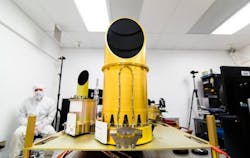Teledyne DALSA’s High Performance Detectors Power “Electronic Eyes” Aboard OSIRIS-REx
Teledyne DALSA, a Teledyne Technologies company and global leader in the design and manufacture of high performance custom imaging solutions, has partnered with the University of Arizona in the development of three high resolution image detectors that will serve as “retinas” for the OSIRIS-REx mission to Bennu, scheduled for launch Thursday, September 8.
Designed, constructed and tested over the last four years, the image sensors aboard OCAMS will behave in a manner similar to human eyes, from spotting the target asteroid from more than a million miles away to monitoring the sampling process just 10 feet from the surface of the asteroid. Space-qualified and radiation-hardened, the Teledyne DALSA CCD detectors feature very low dark signal with a low read out noise, and power each of the 3 cameras that comprise the OCAMS:
The spacecraft will reach Bennu in 2018 and return a sample to Earth in 2023.
"Our mission tries to attempt a lot of things at the same time," OCAMS instrument scientist Bashar Rizk said. "Navigation, mapping, reconnaissance, sample site selection, sampling — we do it on the same trip, so we need to understand what is going on at the asteroid at all times, so we can make decisions in real time when we're there. The most important goal of these cameras is to maximize the chances of successfully bringing back a sample."

